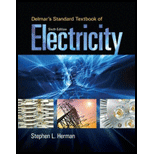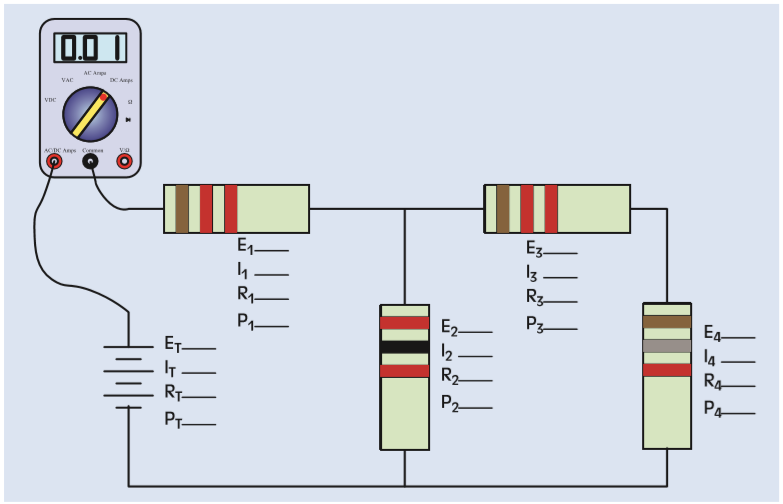
Delmar's Standard Textbook of Electricity (MindTap Course List)
6th Edition
ISBN: 9781285852706
Author: Stephen L. Herman
Publisher: Cengage Learning
expand_more
expand_more
format_list_bulleted
Concept explainers
Textbook Question
Chapter 8, Problem 9PP
Find the missing values for the circuit shown in Figure 8-27.

FIGURE 8-27 Combination circuit.
Expert Solution & Answer
Want to see the full answer?
Check out a sample textbook solution
Students have asked these similar questions
Don't use ai to answer I will report you answer
Don't use ai to answer I will report you answer
Please, I want the solve to the two questions, with a drawing of the equivalent circuit in the case of dc and in the case of small signal.
Chapter 8 Solutions
Delmar's Standard Textbook of Electricity (MindTap Course List)
Ch. 8 - Referto Figure 8-2. Replace the values shown with...Ch. 8 - 2. Refer to Figure 8-5. Replace the values shown...Ch. 8 - 3. Refer to the circuit shown in Figure 8-2....Ch. 8 - Refer to the circuit shown in Figure 6-22. The...Ch. 8 - Refer to Figure 8-21. Assume that the resistors...Ch. 8 - A circuit contains a 1000- and a 300- resistor...Ch. 8 - Two resistors are connected in series. One...Ch. 8 - A single-phase electric motor is connected to a...Ch. 8 - The hot water for the heating system for a small...Ch. 8 - Find the unknown values in the circuit if the...
Ch. 8 - Refer to the circuit shown in Figure 8-21 to solve...Ch. 8 - 3. Find the unknown values in the circuit if the...Ch. 8 - Refer to the circuit shown in Figure 8-25 to solve...Ch. 8 - 5. Find the unknown values in the circuit if the...Ch. 8 - Find the unknown values in the circuit if the...Ch. 8 - Refer to the circuit shown in Figure 8-26 to solve...Ch. 8 - ET E1 E2 E3 E41.248V IT I1 I2 I3 I4 RT R1 R2 R3 R4...Ch. 8 - Find the missing values for the circuit shown in...Ch. 8 - Find the missing values for the circuit shown in...
Knowledge Booster
Learn more about
Need a deep-dive on the concept behind this application? Look no further. Learn more about this topic, electrical-engineering and related others by exploring similar questions and additional content below.Similar questions
- Q2. For the transformer shown in Fig. 1. A. Plot the winding connection for the transformer and justify your answer. (4M) B. If the transformer is adopted in 12 pulse diode rectifier, where two-series connected bridge rectifiers are used to supply a highly inductive load with 100 A. (i) Select a suitable turns ratio for the transformer (ii) Plot the line current of each winding ( secondary + primary) showing the current magnitude at each interval (iii) Use Fourier Page 1 of 3 analysis to obtain the Fourier series of all line currents then calculate the THD of the input current. (8=0° (16M) (Y) = 30° Fig. 1 P. I v Iarrow_forwardQ2. For the transformer shown in Fig.1, A. Find the phase shift between the primary and star-connected secondary. B. If the transformer is adopted in a 12-pulse diode rectifier, where a two-series connected bridge rectifier is connected in series and supplies a highly inductive load (i) Select a suitable turns ratio for the transformer (ii) Plot the line current of each winding (secondary + primary). (iii)Using Fourier analysis to obtain the Fourier series of all line currents, then calculate the THD of the input current. (iv) Draw the output voltage of the first and second rectifiers and give the relation of the total output voltage. N2 B C Fig. 1 N3 aarrow_forwardQ2.A. It is planned to use the transformer shown in Fig. 1, a 12-pulse rectifier. Each secondary is connected to three phase controlled bridge rectifier. The two rectifiers are connected in series to supply a highly inductive load. 1. Based on the phasor relationship between different windings. If suitable turns ratio is selected, is it possible to use this transformer to produce 12 pulse output voltage? Show the reason behind your answer. 2. Assuming this arrangement is possible to be used in 12-pulse rectifier, draw the output voltage of the 1st and 2nd rectifier and give the relation of the total output voltage. 3. Use the Fourier analysis to show the harmonics in all line currents of the transformer. A B in C Fig. 1 b la a 2 b.arrow_forward
- Q4. Give the reasons for the following 1. In AC machines drives, the frequency modulation index should be integer regardless the value of switching frequency. 2. Variable de link voltage is adopted in inverter operating in square wave operation mode 3. Practical values of switch utilization factor is different from theoretical values 4. In three-phase inverter with my is odd and multiple of 3, the even and tripplen harmonics are zero. 5. The PSC-PWM is attractive for the modular multilevel converterarrow_forwardQ6.B. Answer the following questions 1. Does the steady state load current in a half bridge inverter has an average value and what is the adverse effect of the average current component? 2. Can the LPF of single phase bridge inverter based on bipolar PWM be used with single phase bridge inverter based on unipolar PWM? Explainarrow_forwardQ3. Answer the following questions T 1. Compared to the bipolar voltage-switching scheme, the unipolar scheme is "effectively" doubling the switching frequency. Explain the statement's meaning and how this effect can be generated. 2. What are the properties of a good power switch, and what are its basic ratings? 3. What are the objectives of any PWM strategy for three-phase inverters? 4. Why is the current control PWM rectifier in the dq rotating reference frame preferred over the abc reference frame? 5. Define the switch utilization factor. Show how this factor can be calculated for different single-phase inverters for square wave operation mode at the maximum rated output.arrow_forward
- Q1.B. Explain output control by voltage cancellation in a single-phase inverter. What are the advantages over square wave operation?arrow_forwardQ3.B. What is the problem of three-phase HW rectifier and how can be resolved?arrow_forwardQ3-consider the unity feedback system shown below: a.Evaluate general formula of ess? b.Calculate the steady state error of the closed loop system due to R(s) unit step input, D(s)=0]? c.Calculate the steady-state response when D(s) and ramp and R(s)=0?arrow_forward
arrow_back_ios
SEE MORE QUESTIONS
arrow_forward_ios
Recommended textbooks for you
 Delmar's Standard Textbook Of ElectricityElectrical EngineeringISBN:9781337900348Author:Stephen L. HermanPublisher:Cengage Learning
Delmar's Standard Textbook Of ElectricityElectrical EngineeringISBN:9781337900348Author:Stephen L. HermanPublisher:Cengage Learning Electricity for Refrigeration, Heating, and Air C...Mechanical EngineeringISBN:9781337399128Author:Russell E. SmithPublisher:Cengage Learning
Electricity for Refrigeration, Heating, and Air C...Mechanical EngineeringISBN:9781337399128Author:Russell E. SmithPublisher:Cengage Learning EBK ELECTRICAL WIRING RESIDENTIALElectrical EngineeringISBN:9781337516549Author:SimmonsPublisher:CENGAGE LEARNING - CONSIGNMENT
EBK ELECTRICAL WIRING RESIDENTIALElectrical EngineeringISBN:9781337516549Author:SimmonsPublisher:CENGAGE LEARNING - CONSIGNMENT

Delmar's Standard Textbook Of Electricity
Electrical Engineering
ISBN:9781337900348
Author:Stephen L. Herman
Publisher:Cengage Learning

Electricity for Refrigeration, Heating, and Air C...
Mechanical Engineering
ISBN:9781337399128
Author:Russell E. Smith
Publisher:Cengage Learning

EBK ELECTRICAL WIRING RESIDENTIAL
Electrical Engineering
ISBN:9781337516549
Author:Simmons
Publisher:CENGAGE LEARNING - CONSIGNMENT
Current Divider Rule; Author: Neso Academy;https://www.youtube.com/watch?v=hRU1mKWUehY;License: Standard YouTube License, CC-BY